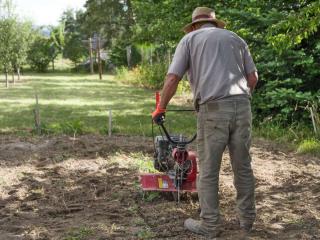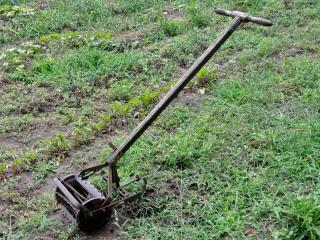

A rototiller is a very useful when starting a vegetable patch or lawn, and it also helps for tilling the soil, hoeing and cultivating or removing weeds.
Whether the surface is large or small, a mini tiller or a rototiller will greatly ease any garden work and will keep you from wasting efforts or hurt your back.
Although this equipment was originally designed for professionals, nowadays a wide range of products are available for home gardeners.
A rototiller is what you need for surfaces larger than 600 sq yd (500 m²).
 Usually set up with 4 to 10 Hp engines, rototillers usually sport their blades at the back of the device.
Usually set up with 4 to 10 Hp engines, rototillers usually sport their blades at the back of the device.
The engine drives the wheels with a belt or shaft.
It often comes with gears of various speeds, including reverse, so handling it is quite easy.
It is an essential tool for preparing new lawns and also to till and maintain the vegetable patch in fall and at the beginning of spring. Note that it’s the best way to mix soil conditioner and compost into the ground.
Advantages of the rototiller
Disadvantages of the rototiller
 Usually, smaller 4 to 6 Hp engines power these. It is used for the upkeep of flower beds or to weed your vegetable patch.
Usually, smaller 4 to 6 Hp engines power these. It is used for the upkeep of flower beds or to weed your vegetable patch.
Unlike the rototiller, the machine isn’t pulled by wheels, but is driven by the blades themselves.
The more powerful the engine, the more blades are attached and the wider the breadth that is tilled.
If you’ve got to set up a lawn, best select a rototiller: the blades run deeper than those of a mini tiller. A mini tiller will certainly not be powerful enough for an entire lawn.
Advantages of the mini tiller
Disadvantages of the mini tiller
To sum it up, purchasing a rototiller or a mini tiller essentially depends on the use you’re going have for it.
Even if the cost varies from one design to the next, regular care for a vegetable patch or creating a lawn will require a rototiller, whereas most other garden tasks can easily be performed by a mini tiller, or even, if done only rarely, a simple hoe.